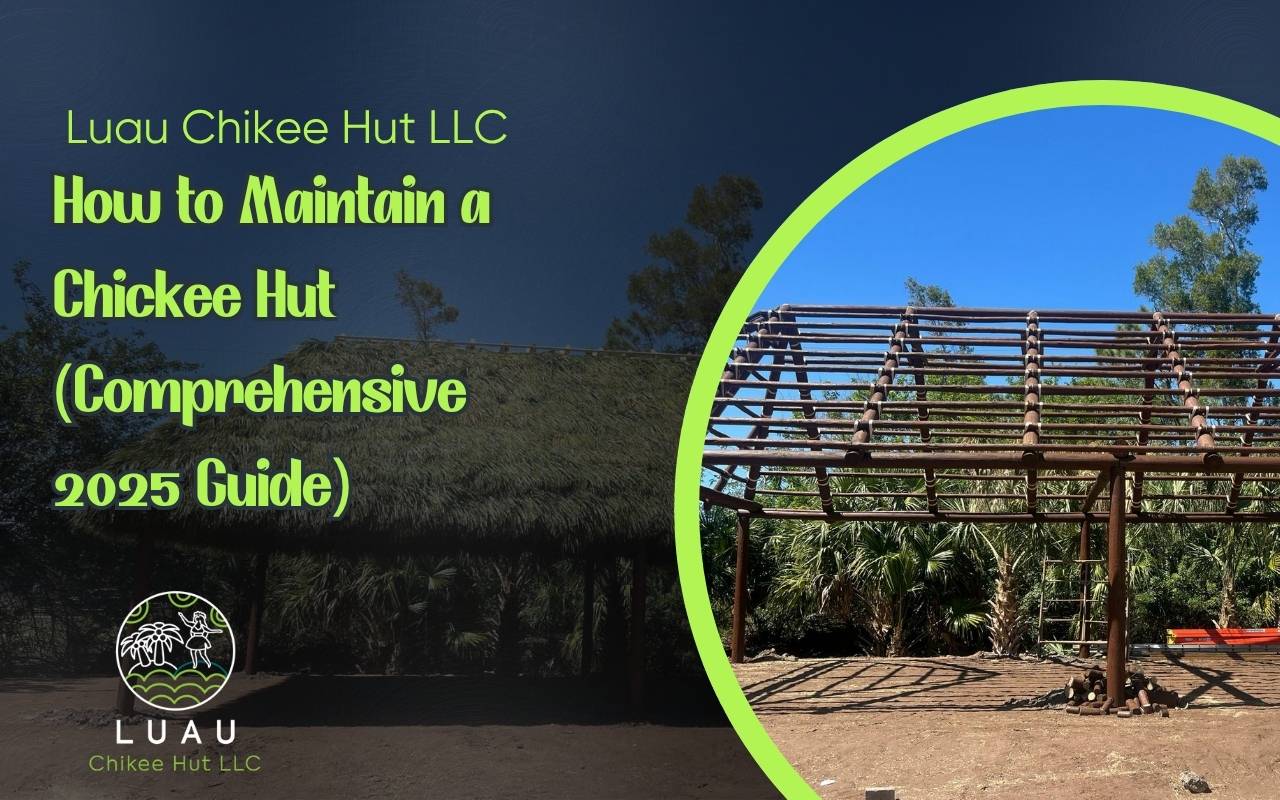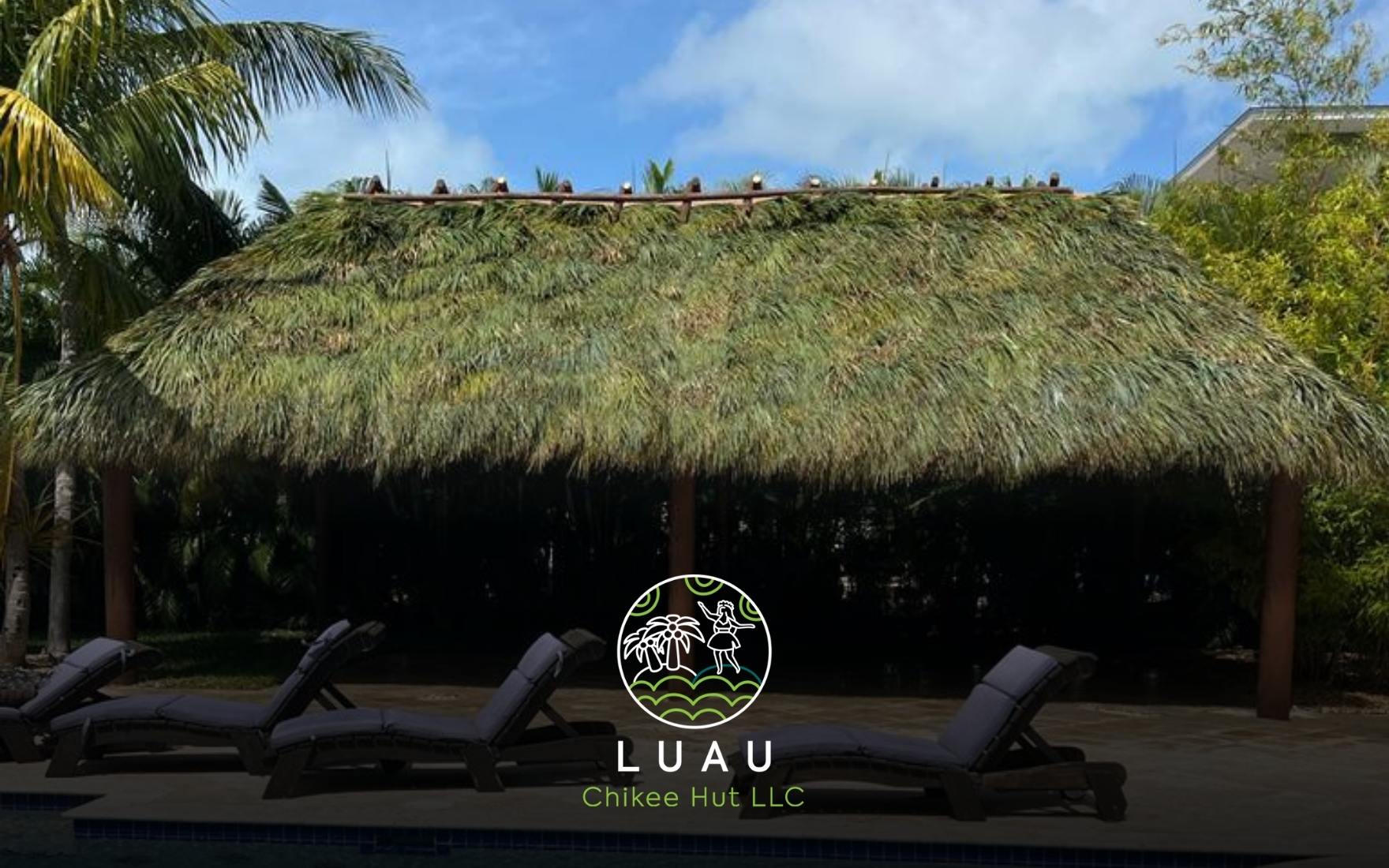
If you’ve invested in a tropical backyard retreat, knowing how to maintain a chickee hut is essential for keeping it strong, safe, and beautiful. Rooted in the craftsmanship of the Seminole Tribe, these open-air shelters represent cultural heritage and natural comfort. However, Florida’s tropical climate—with its humidity, storms, and salt exposure—means your hut requires consistent care throughout the year.
At Luau Chickee Hut LLC, we specialize in tiki hut remodeling, rethatching, and maintenance services across South Florida. In this updated 2025 guide, you’ll discover practical ways to care for your hut through every season. These expert insights will help you understand how to maintain a chickee hut efficiently and effectively.
Understanding Basic Chickee Hut Care
Start with essential care to prevent common problems like mold, pests, or premature thatch wear. Keeping a consistent routine ensures your hut remains sturdy and inviting. Below are a few key tips to begin with:
- Keep the area around your hut free from leaves, weeds, and debris.
- Trim overhanging branches to reduce moisture and allow airflow.
- Avoid hanging heavy lights or décor unless the structure supports it.
Regular upkeep maintains airflow, discourages pests, and preserves thatch resilience. These steps help create a weatherproof environment and support long-term structural integrity.
Fall/Winter Maintenance: Why It Matters
Florida’s cooler months bring lower humidity and fewer insects, yet they also bring high winds, rain, and salt exposure. Proactive care during this time helps prevent damage and ensures durability through the stormy months. Here are seasonal actions to take:
- Inspect thatch for dryness, discoloration, or thinning spots.
- Check wood supports for rot, pest activity, or corrosion.
- Clean dust, pollen, and debris from the roof carefully.
- Apply protective sealants and UV blockers on exposed wood.
These habits will extend your hut’s lifespan and keep it ready for any weather. For professional assistance, explore our Services page to learn about our remodeling and rethatching options.
Post-Storm Checks and Repairs
After major weather events, inspect your structure closely. Look for sagging areas, cracks, or loose thatch. Focus on roof ridges and eaves since wind and rain often strike hardest there. Minor thatch repairs can be handled quickly, but deeper structural issues should be left to experts.
Using treated lumber and weather-resistant fasteners reinforces your hut and prevents recurring damage. Maintain a detailed log to track inspections and repairs. This record will help you understand how to maintain a chickee hut and respond effectively after each storm.

Bug and Pest Deterrent Strategies
Florida’s tropical climate attracts termites, ants, and rodents. To safeguard your investment, create a thorough pest deterrent plan:
- Clear debris and vegetation near your hut.
- Apply eco-friendly insecticides or borate-based wood treatments.
- Inspect posts for mud tubes, chewed wood, or droppings.
- Use fine mesh screens and flashing to seal small openings.
Preventive action saves time and cost over time. If an infestation occurs, contact a licensed professional quickly to avoid long-term structural issues.
Combating Salt and UV Damage in Coastal Areas
Coastal huts face continuous exposure to salt air and sunlight. Salt corrodes metal connectors, while UV rays can weaken thatch fibers. Follow these steps to protect your structure:
- Use stainless steel or hot-dipped galvanized fasteners.
- Rinse hardware and posts with fresh water regularly.
- Apply marine-grade sealant every two to three years.
- Spray UV protectant products on thatch and wooden parts.
This combination of salt and UV care helps preserve your hut’s color and strength. Understanding how to maintain a chickee hut in coastal areas ensures long-term beauty and resilience.
Safe Cleaning and Thatch Care
Cleaning your thatch roof requires gentle care to avoid damage. Sweep with a soft broom or use a low-pressure blower to remove debris. Avoid power washing since it can harm the fibers. Remove bird droppings and pollen carefully to keep your hut clean.
If buildup becomes severe, consider professional help from Luau Chickee Hut LLC. Thatch typically lasts five to ten years, depending on exposure. Signs you need rethatching include leaks, bare patches, or frayed areas. Learning how to maintain a chickee hut includes recognizing when it’s time for rethatching or roof care.
Choosing the Right Materials
Durable materials are crucial for your hut’s longevity. Opt for pressure-treated or naturally rot-resistant wood like cypress or cedar. Seal with an exterior-grade, non-toxic finish for protection. Use locally sourced palm fronds when rethatching to ensure authenticity and performance under Florida’s climate.
All fasteners should resist humidity and salt exposure. Investing in reliable materials enhances your hut’s strength and keeps its traditional look intact.
Seasonal Maintenance Checklist
Following a structured routine simplifies upkeep and guarantees consistent results. Use this checklist as part of your plan:
- Inspect thatch, poles, fasteners, and joints regularly.
- Clean roof surfaces, beams, and surrounding areas.
- Protect wood using sealants, pest treatments, and UV finishes.
- Repair any visible damage promptly.
- Document inspections and maintenance dates in a log.
By following these steps, you’ll fully grasp how to maintain a chickee hut year-round while preserving both beauty and safety.
FAQs About Chickee Hut Maintenance
How often should I inspect my chickee hut?
Inspect your hut twice a year, especially before and after hurricane season, to detect wear early and prevent costly repairs.
Can I clean the thatch roof myself?
Yes, but always use gentle methods. Avoid high-pressure water and harsh chemicals that can damage the natural fibers.
How long does a chickee thatch last?
Typically, thatch lasts between five and ten years, depending on materials and weather exposure. Regular care extends its life.
What materials are best for long-lasting huts?
Pressure-treated wood and locally sourced palm fronds offer durability and respect traditional design methods.
Where can I get professional help?
Contact our team through the Contact Us page to schedule a maintenance or inspection service with our experts.
Enhancing Aesthetics and Comfort
Maintenance also enhances comfort and visual appeal. Add weatherproof lighting, bamboo accents, or natural curtains for charm and usability. Incorporate native plants and pathways around your hut to manage moisture and improve curb appeal.
For remodeling or upgrading your outdoor retreat, explore our Services to see how we can help enhance your space with expert craftsmanship.
Ensuring the Longevity of Your Chickee Hut
From pest prevention and post-storm checks to UV and salt care, consistency is key. Combining traditional techniques with modern solutions ensures your hut remains strong and beautiful for years. By learning how to maintain a chickee hut, you’ll preserve its functionality and cultural value over time.
Whether you’re caring for a new build or an older structure, Luau Chickee Hut LLC is here to assist. Reach out through our Contact Us page today to book an inspection or schedule rethatching for your tropical retreat.



